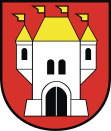Kowal
| Kowal | ||
|---|---|---|

|
|
|
| Basic data | ||
| State : | Poland | |
| Voivodeship : | Kuyavian Pomeranian | |
| Powiat : | Włocławek | |
| Area : | 4.68 km² | |
| Geographic location : | 52 ° 32 ' N , 19 ° 9' E | |
| Height : | 90 m npm | |
| Residents : | 3479 (Jun. 30, 2019) |
|
| Postal code : | 87-820 | |
| Telephone code : | (+48) 54 | |
| License plate : | CWL | |
| Economy and Transport | ||
| Street : | DK1 Włocławek - Krośniewice | |
| Rail route : | Kutno – Toruń | |
| Next international airport : |
Łódź Bydgoszcz |
|
| Gmina | ||
| Gminatype: | Borough | |
| Residents: | 3479 (Jun. 30, 2019) |
|
| Community number ( GUS ): | 0418011 | |
| Administration (as of 2008) | ||
| Mayor : | Eugeniusz Gołembiewski | |
| Address: | ul. Piwna 24 87-820 Kowal |
|
| Website : | www.kowal.eu | |
Kowal ( German 1939–1943 Freistadt , 1943–1945 Kowall ) is a town in Poland in the Kuyavian-Pomeranian Voivodeship . Kowal forms a municipality and is also the seat of a rural municipality .
history
The timing of today's Kowal is not known. The first written mention of the city comes from January 20, 1185. On April 30, 1310, the later Polish King Casimir III. have been born here.
The Teutonic Order destroyed the town and castle during two crusades in 1327 and 1331 and incorporated the area into the Teutonic Order state until the Peace of Kalisch in 1343 .
After the place was part of Poland again, Kowal received city rights , this award was renewed in 1519 by Sigismund I.
From 1793 to 1807 Kowal came temporarily to Prussia through the Second Partition of Poland .
1807 Kowal was the formation of the Duchy of Warsaw polish again, but came in 1815 after the Congress of Vienna as part of Congress Poland to the Russian Empire . After the Polish uprising in January 1864, Tsar Alexander II reduced the number of places with town charter on Polish territory, and so Kowal lost his town charter in 1870.
With the end of the First World War , the place became part of the re-established Poland in 1918 and was again granted city rights.
At the beginning of the Second World War , Kowal was hit by two aerial bombs on September 3, 1939, and the German Wehrmacht occupied the city on September 13, 1939 . During the occupation, around 1,500 Jews from the city were deported to ghettos and concentration camps, only a few survived. On January 19, 1945, Soviet soldiers from the 1st Belarusian Front marched into Kowal. As a result, the city became part of Poland again.
Population development
At the beginning of the 17th century there were 240 houses in Kowal, in which about 1,440 people lived. At the end of the 17th century, after the Northern Wars , only 30 houses were counted. In the interwar period , around 4,000 to 5,000 people lived in the city. These were Poles, Jews, and Germans, and accordingly there were also three main religions: Catholic, Protestant, and Jewish.
Kowal rural community
The rural community of Kowal, to which the city itself does not belong, has an area of 114.7 km² and 3922 people live on it (as of June 30, 2019).
Economy and Infrastructure
traffic
The town of Kowal is located on Landesstraße 1 , which runs in a north-south direction, which is also Europastraße 75 . This leads in the north after about 15 kilometers through Włocławek and in the south after about 30 kilometers to Krośniewice . In the future, the A1 Autostrada will pass the city. Furthermore, the Wojewodschaftsstraße 265 ( droga wojewódzka 265 ) runs through Kowal in an east-west direction . In a westerly direction it leads after about 18 kilometers through Brześć Kujawski , in the east after 25 kilometers through Gostynin . Voivodeship Road 269 begins in Kowal. It runs in a south-westerly direction and leads through Chodecz after about 20 kilometers .
Gołaszewo has a stop on the Kutno – Piła railway line .
The nearest two international airports are Łódź Władysław Reymont Airport , about 90 kilometers to the south, and Bydgoszcz Ignacy Jan Paderewski Airport , about 100 kilometers to the northeast.
Personalities
sons and daughters of the town
- Casimir III (1310–1370), King of Poland
- Max Kowalski (1882–1956), composer, singer, singing teacher and lawyer.
- Jan Nowicki (* 1939), actor
Footnotes
- ↑ a b population. Size and Structure by Territorial Division. As of June 30, 2019. Główny Urząd Statystyczny (GUS) (PDF files; 0.99 MiB), accessed December 24, 2019 .
- ↑ a b Website of the city, "Historia - Historia Kowala" , accessed on December 22, 2009
